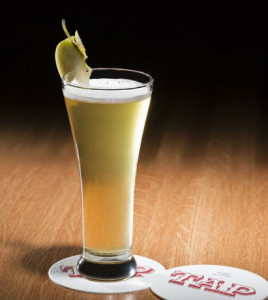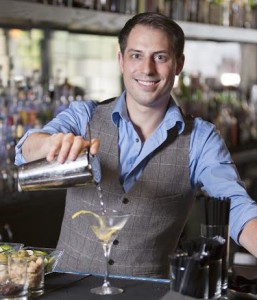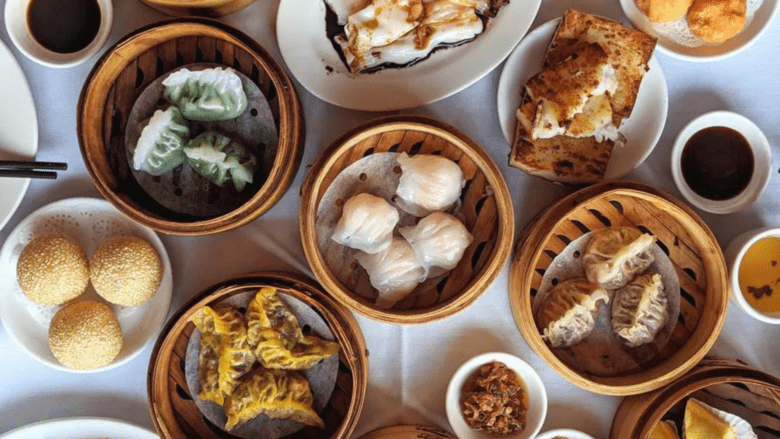What with the whole Thanksgiving thing, November seems the time to take a look back at Boston’s early settlers—and their feasting habits. For a taste of how the city’s forebears would have celebrated, look to Michael Boughton at The Tap Trailhouse. Boughton, who serves as Beverage Director for Boston Nightlife Ventures, curated the Trailhouse’s colonial-leaning cocktail menu by researching into the drinking of days past. He recently taught a hands-on class on the topic and he uses his boozy knowledge to switch up the beverage list by season, interpreting drinks from the era of the tavern for modern-day palates.
 The drinking culture of early Boston wasn’t just celebratory—as Boughton puts it, “They drank every day, all day.” The colonists were putting away gallons and gallons of alcohol partly out of necessity. Unsanitary water conditions meant it was safer for men, women (and yes, even children) to drink beer to quench their thirst. “Pretty much every household was making beer because they could grow grain right in their backyard,” Boughton explains. The preponderance of New England apple trees allowed the settlers to make their own hard cider, as well. The household outputs found their way into cocktails like the Stone Fence, a dark rum-hard cider beverage. But, Boughton says, “their tastes were basic and crude. The colonists didn’t have the best of ingredients, or liquors.” He reinvents the Stone Fence recipe with cinnamon syrup and Downeast Original Cider, and a house-infused apple pie rum.
The drinking culture of early Boston wasn’t just celebratory—as Boughton puts it, “They drank every day, all day.” The colonists were putting away gallons and gallons of alcohol partly out of necessity. Unsanitary water conditions meant it was safer for men, women (and yes, even children) to drink beer to quench their thirst. “Pretty much every household was making beer because they could grow grain right in their backyard,” Boughton explains. The preponderance of New England apple trees allowed the settlers to make their own hard cider, as well. The household outputs found their way into cocktails like the Stone Fence, a dark rum-hard cider beverage. But, Boughton says, “their tastes were basic and crude. The colonists didn’t have the best of ingredients, or liquors.” He reinvents the Stone Fence recipe with cinnamon syrup and Downeast Original Cider, and a house-infused apple pie rum.
Rum was the spirit of the hour (or era) because it was cheap and easily accessible. British navy men were given a daily ration of gin aboard ship but the speed at which they put it away and the rising cost of the liquor led to daily rations of rum instead. Sailors added citrus and sugar to make the dark spirit more palatable, creating the grog cocktail (and, unwittingly, the daiquiri). Upgrading grog from sea swill, Boughton uses cinnamon syrup and black tea to give the drink tasty depth.
 Adding rum to the bountiful amounts of beer led to what Boughton considers the quintessential colonial cocktail: the flip. “Things like punches [which Boughton has modified for individual servings on the menu] typically required more exotic ingredients, like nutmeg and citrus, things that didn’t grow in colonial New England. I would say the flip is the common man drink of the colonial era.” The Trailhouse’s version shakes up Bully Boy White Rum with molasses syrup, Angostura bitters and a whole egg, served with brown ale and a grating of nutmeg for that holiday flavor. Boughton’s next menu update will include another rum-beer cocktail called the Rattle Skull, which features early settler favorite sherry, cognac and vanilla for a well-balanced, deep drink with lingering notes of butterscotch. “I didn’t deviate too much from the original recipe,” Boughton says, “other than using local products and higher quality ingredients.”
Adding rum to the bountiful amounts of beer led to what Boughton considers the quintessential colonial cocktail: the flip. “Things like punches [which Boughton has modified for individual servings on the menu] typically required more exotic ingredients, like nutmeg and citrus, things that didn’t grow in colonial New England. I would say the flip is the common man drink of the colonial era.” The Trailhouse’s version shakes up Bully Boy White Rum with molasses syrup, Angostura bitters and a whole egg, served with brown ale and a grating of nutmeg for that holiday flavor. Boughton’s next menu update will include another rum-beer cocktail called the Rattle Skull, which features early settler favorite sherry, cognac and vanilla for a well-balanced, deep drink with lingering notes of butterscotch. “I didn’t deviate too much from the original recipe,” Boughton says, “other than using local products and higher quality ingredients.”
The Rattle Skull and more are coming on the fall-winter menu, as well as some warm cocktails to combat that New England chill. In the meantime, follow the Freedom Trail to The Tap Trailhouse’s door, literally, to partake in Boston’s long libation history.

















